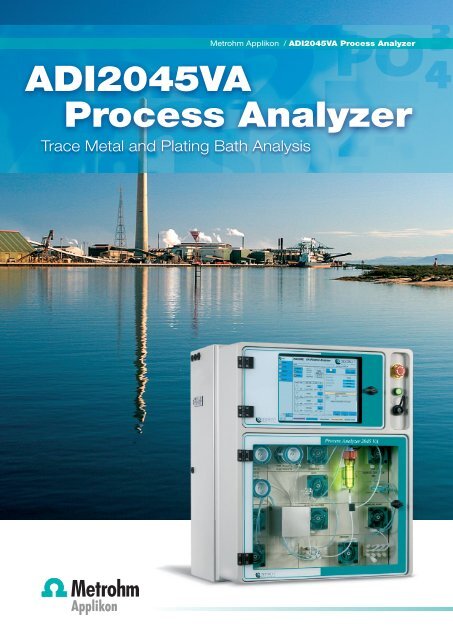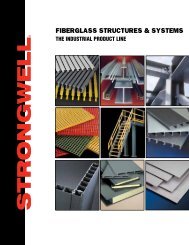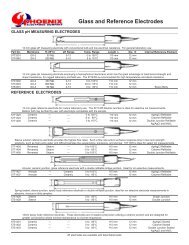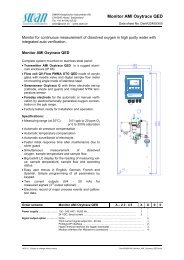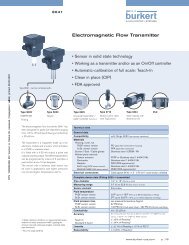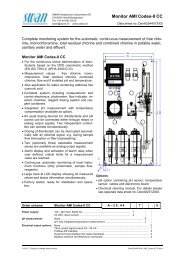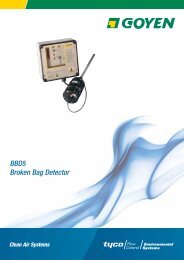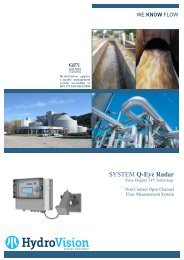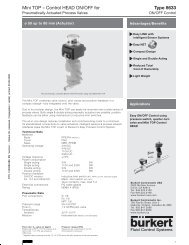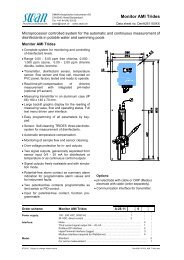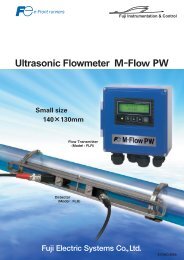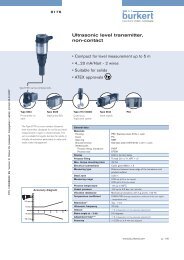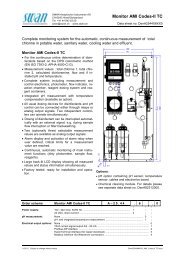ADI2045VA Process Analyzer - Applikon BV
ADI2045VA Process Analyzer - Applikon BV
ADI2045VA Process Analyzer - Applikon BV
Create successful ePaper yourself
Turn your PDF publications into a flip-book with our unique Google optimized e-Paper software.
Metrohm <strong>Applikon</strong> / <strong>ADI2045VA</strong> <strong>Process</strong> <strong>Analyzer</strong><br />
<strong>ADI2045VA</strong><br />
<strong>Process</strong> <strong>Analyzer</strong><br />
Trace Metal and Plating Bath Analysis
Trace Metal and Plating Bath Analysis<br />
Metrohm <strong>Applikon</strong> On-Line <strong>Analyzer</strong>s<br />
Metrohm <strong>Applikon</strong> B.V. has over 25 years of experience<br />
with on-line measurements in the chemical industry, waste<br />
water treatment plants, power plants etc. All of the analyzers<br />
are used directly in the process and are able to run 24 hours<br />
a day to continuously monitor the components of interest.<br />
The Metrohm <strong>Applikon</strong> analyzers use well proven analysis<br />
techniques, like: Colorimetry, ISE standard addition, Titration,<br />
Ion Chromatrography and now also Voltammetric Analysis.<br />
Due to the close collaboration with Metrohm AG, a world<br />
leader in ion analysis, Metrohm <strong>Applikon</strong> has access to<br />
a large database of applications for laboratory-based<br />
measurements and instrument technology that can be used<br />
as a basis for on-line applications. In the translation step<br />
from a laboratory application to an on-line application, the<br />
extensive experience that Metrohm <strong>Applikon</strong> has in sampling<br />
and sample pre-conditioning plays an important role.<br />
On-line VA analysis<br />
The Metrohm <strong>Applikon</strong> 2045VA analyzer<br />
is an on-line <strong>Process</strong> <strong>Analyzer</strong> based on<br />
the principle of Voltammetric Analysis. This<br />
measurement method has routinely been<br />
applied in the lab for several decades now.<br />
Metrohm <strong>Applikon</strong> has now made this<br />
method available on-line so that it can be<br />
used directly in the process stream.<br />
Voltammetric analysis is a technique that is<br />
mostly used for trace metal analysis as well<br />
as quality control of plating baths.<br />
797 Computrace<br />
Settler preconditioner for 2 sample streams<br />
2045VA <strong>Analyzer</strong><br />
The 2045VA system is built in the same housing as the<br />
well known and proven 2040 multi-purpose analyzer. Its analytical<br />
heart is the 797 Computrace VA system of Metrohm,<br />
the most well known laboratory VA system. In this system<br />
either a so-called Multi Mode Electrode (MME) or a Rotating<br />
Disk Electrode (RDE) is used. The advantage of this setup<br />
is that the same methods can be used as are being developed<br />
and used in the lab. Around the analysis vessel with<br />
the MME or RDE, the burettes, pumps and preconditioning<br />
modules (if needed) are placed.
Metrohm <strong>Applikon</strong> / <strong>ADI2045VA</strong> <strong>Process</strong> <strong>Analyzer</strong><br />
Flexibility in wet-part design<br />
for different applications<br />
Depending on the application the so-called wetpart can<br />
be configured choosing the right wet part modules like<br />
sampling valves, tubing pumps, dosino’s, valves and other<br />
modules.<br />
Complete Wetpart<br />
Depending on the application, the number of burettes may<br />
change, or an UV digester may or may not be present.<br />
The ADI2045 layout drawing gives an overview of the possible<br />
wet-part modules as well as the possible in- and outputs for<br />
Hydraulic Planning Sheet of the Wet Part<br />
results, alarms, remote control, etc...<br />
External<br />
Ethernet<br />
RS232<br />
Touch screen<br />
Display<br />
DO<br />
• Replaceable<br />
memory media<br />
• Keyboard<br />
USB<br />
IPC<br />
Controller<br />
Ethernet<br />
I/O Module<br />
Control<br />
DI<br />
AO<br />
External devices<br />
• Pointing device<br />
USB<br />
Computrace<br />
Controller<br />
Dosing Interface<br />
USB<br />
MSB<br />
Wet part devices<br />
Switch<br />
Digester<br />
Valves<br />
Sample<br />
detector<br />
RDE or MME<br />
Dosino’s<br />
Pumps<br />
<strong>ADI2045VA</strong> Layout<br />
Operation<br />
The system is controlled by an Industrial PC (IPC) in combination with a programmable logic controller (PLC ). The PLC controls all<br />
external and wet part devices, while the Computrace and Dosino burettes are driven directly by the IPC.<br />
The system Graphical User Interface (GUI) consists of a touch screen display making operation easy and intuitive. An additional keyboard<br />
and pointing device can be connected via an USB port if necessary. The operation bar gives a number of operation options<br />
while the status bar shows system status at every moment. The user is informed about relevant events, like e.g. result limit alarms, by<br />
means of a pop-up window that can be acknowledged.
Trace Metal and Plating Bath Analysis<br />
Main screen<br />
The access to the operation button can be protected, while<br />
e.g. analysis results are still displayed. Two operation levels<br />
are possible which can be accessed by various users and<br />
password protection; one for daily operation and one for<br />
configuring and programming the instrument. It is also possible<br />
to access the GUI of the Computrace software, giving access to<br />
analysis method parameters and voltammograms.<br />
The 2045VA sequence program<br />
The analysis procedure is performed in a sequence of<br />
runs. First a programmable number of Clean RUNS can be<br />
performed, next a number of Reference RUNS in which<br />
a calibration or reference sample is analyzed, and finally<br />
a number of Analysis RUNS divided over a maximum of 4<br />
possible sample streams.<br />
Action list editor<br />
The runs consist of programmable<br />
action lists that control the<br />
wet part devices as required and<br />
call Computrace analysis methods.<br />
Optionally Conditional actions can be<br />
programmed making the ADI2045 VA<br />
a powerful intelligent analyzer. It is,<br />
for example, possible to speed-up (or<br />
slow-down) the analysis frequency<br />
if analysis results are exceeding set<br />
alarm limits.<br />
Conditional actions<br />
Action list editor
Metrohm <strong>Applikon</strong> / <strong>ADI2045VA</strong> <strong>Process</strong> <strong>Analyzer</strong><br />
Result display, trend graph<br />
Results are presented in a listed view or in a graphical<br />
view, which appearance can be adapted as required, i.e.<br />
scales, colors and pointers to indicate set point and alarm<br />
limits in a trend graph and bar graph<br />
Events, like occurred result alarms, device warnings and<br />
errors, control actions, configuration changes etc, are stored<br />
in a logbook. A logbook viewer is available to inspect all<br />
occurred events in a historical overview.<br />
Finally all external and wet part devices can be manually<br />
operated for maintenance purposes. All relevant system<br />
information, like analysis results, logbook events, system<br />
configuration, info, action lists and data can be exported<br />
in XML-format on removable memory media (like a memory<br />
stick) connected to the available USB-port. The port is easily<br />
accessible on the front of the analyzer cabinet.<br />
Voltammetric Analysis<br />
Voltammetry is an electrochemical technique in which a current<br />
as a result of an electron transfer is measured. A potential<br />
that varies in time is applied to an electrode, a redox reaction<br />
will take place of which the current is then measured.<br />
In Stripping Voltammetry, a metal (ion) in solution is reduced<br />
and deposits onto the mercury electrode. In a second step then,<br />
a more positive potential is applied to the electrode, due to<br />
which the metal is oxidised and stripped of the metal surface.<br />
The current (or charge) that flows while oxidising the metal is<br />
directly related to the amount of metal and to the concentration<br />
in solution. Due to the fact that a kind of pre-concentration step<br />
(the deposition of the metal) is used in this process, voltammetry<br />
is capable of achieving very low sensitivities (see table).<br />
Example of a determination with the Computrace of Cd and Pb concentrations<br />
in tap water. Voltammograms (left) and standard addition curves (right) are shown.<br />
Detection limits<br />
Antimony SbIII/SbV 200 ppt<br />
Bismuth Bi 500 ppt<br />
Cadmium Cd 50 ppt<br />
Chromium CrIII/CrVI 25 ppt<br />
Cobalt Co 50 ppt<br />
Copper Cu 50 ppt<br />
Iron FeII/FeIII 50 ppt<br />
Lead Pb 50 ppt<br />
Mercury Hg 100 ppt<br />
Molybdenum MoIV/MoVI 50 ppt<br />
Nickel Ni 50 ppt<br />
Platinum Pt 0.1 ppt<br />
Rhodium Rh 0.1 ppt<br />
Selenium SeIV/SeVI 300 ppt<br />
Thallium Tl 50 ppt<br />
Tungsten W 200 ppt<br />
Uranium U 25 ppt<br />
Zinc Zn 50 ppt<br />
Voltammetry allows to distinguish the different oxidation stages of metal ions or differentiate between free and bound metal ions<br />
as well as to specify the biological availability of heavy metals. This makes voltammetry into an essential tool for environmental analysis.<br />
Comparable insights can only be gained by spectroscopy after complicated separation of the metal species.
Trace Metal and Plating Bath Analysis<br />
MME, Multi Mode Electrode<br />
As a working electrode for the system, small mercury drops<br />
are formed at the end of a capillary. The Multi Mode Electrode<br />
(shown in the picture) has a mercury reservoir of 6 ml and is<br />
ideally suited for (heavy) metal analysis.<br />
The advantage of the MME system over the so-called Thin Film<br />
Mercury Electrodes is that a new surface is generated every<br />
time, and cleaning of the surface is not a concern.<br />
Mercury consumption of the system is extremely low, as the<br />
electrode reservoir contains enough mercury for 200,000 drops,<br />
which is enough for > 10,000 analysis or ~200 days of operation.<br />
The mercury during and after the analysis is collected and<br />
disposed of in a safe manner.<br />
Mining<br />
Metrohm Multi Mode Electrode<br />
with Hg reservoir and capillary<br />
On-line use of Voltammetric Analysis is of importance in<br />
mining processes and in the control of water quality. In Zinc<br />
mining for example, the technique can be applied during smelting,<br />
purification, electrolysis or in the control of the process<br />
water. Very often in this case, Cu, Cd and Pb are measured<br />
in combination with Zn. Applications are also available for the<br />
mining of Au, Cu and other metals, for the control of trace metal<br />
concentrations.<br />
A range of applications are possible in drinking water, waste<br />
water, surface water, river water, etc. Species that are mostly<br />
determined are Zn, Cu, Cd, Pb, Co and Ni. In many cases it<br />
is necessary to digest the sample (using the UV digester in the<br />
analyzer) to free the metal(s) from their organic complexes.<br />
During and after the analysis, mercury is collected<br />
on the bottom of the analysis vessel and is<br />
then drained off into a mercury trap. It is always<br />
kept under liquid, so no mercury vapor is allowed<br />
to escape and the safety risk for the user is thus<br />
minimised. The mercury trap can be exchanged for<br />
a clean one, so that the collected mercury can be<br />
disposed of in the right way. Over a period of 10<br />
years, with 50 analysis per day, a total of 100 ml<br />
mercury is consumed.<br />
UV Digester<br />
When doing metal analysis often a part is bound in (organic)<br />
compounds. The digester module is applied in order to release<br />
these metals, which can be done by exposing the sample to<br />
UV radiation, possibly in combination with an oxidizer (usually<br />
Peroxide) and acid. Now all metals are determined in a subsequent<br />
VA analysis. Another application of the digester is to eliminate<br />
substances that interfere with the VA analysis. These substances<br />
(e.g. Thio-Urea or Peroxide) are then simply destructed<br />
to inactive molecules like water and Carbon dioxide.
Metrohm <strong>Applikon</strong> / <strong>ADI2045VA</strong> <strong>Process</strong> <strong>Analyzer</strong><br />
Cyclic Voltammetric Stripping<br />
Cyclic Voltammetric Stripping Analysis (CVS) and<br />
Cyclic Pulse Voltammetric Stripping Analysis (CPVS) are<br />
widespread methods in the electroplating industry for the<br />
determination of organic additives in electroplating baths.<br />
For many technical coatings, particularly in the manufacture<br />
of PCBs and semiconductor components, this method<br />
forms an essential part of production control. In these analyses<br />
instead of a Mercury electrode, a rotating disk electrode<br />
made of platinum is used. The quantitative determination of<br />
the additive is carried out indirectly via its influence on the<br />
deposition of the main components of the electroplating bath.<br />
As the measurement is based on an electrode reaction that<br />
corresponds to the production process, the activity of the<br />
additive and thus its effectiveness in the galvanization<br />
process can be measured instantly.<br />
Cell with electrodes for CVS analysis of a Cu bath<br />
The most important fields of application for this method are:<br />
• Acidic copper baths<br />
• Tin-lead baths and tin baths<br />
• Alkaline zinc baths<br />
Example of a suppressor determination in an acid copper bath.<br />
Actual measured curves are shown on the left, and the calibration curve on the right.<br />
Quantification of brighteners, levelers and suppressors require<br />
different calibration methods that have all been implemented<br />
in the Computrace software.<br />
With CVS or CPVS the concentration of the additive can be<br />
determined exactly. The effective concentration of the particular<br />
additive in the bath sample is given in ml additive per L bath<br />
liquid. This guarantees continuous and interference-free operation<br />
of the plating bath. In particular, the accuracy of the analytical<br />
results has helped the method to become generally accepted<br />
in the electroplating industry.<br />
Water<br />
Metal plating Semiconductor
Metrohm <strong>Applikon</strong> / <strong>ADI2045VA</strong> <strong>Process</strong> <strong>Analyzer</strong><br />
Specifications <strong>ADI2045VA</strong><br />
Applied Analysis methods<br />
<strong>ADI2045VA</strong><br />
DP (Differential Pulse)<br />
SQW (Square Wave)<br />
CVS (Cyclic Voltammetric Stripping)<br />
CPVS (Cyclic Pulse Voltammetric<br />
Stripping)<br />
Sampling and sample streams<br />
Sampling<br />
batch wise<br />
Sample frequency<br />
programmable<br />
Analysis time<br />
typical 30 minutes<br />
Sample streams maximum 4<br />
Sample volume<br />
0.2 – 50 ml<br />
Sample temperature 5 - 45 ºC<br />
Sample pressure<br />
0 - 2 Barg / 0 - 28 PSIG<br />
(without preconditioner)<br />
Maintenance<br />
Weekly<br />
Monthly<br />
6-monthly<br />
Connectivity<br />
Discrete I/O:<br />
Analog Result output<br />
Digital remote control<br />
visual inspection<br />
reagents supply<br />
maintenance check<br />
4 – 20 mA, max 16 ea.<br />
24 VDC, Start, Stop, Continue,<br />
Sample Override 1, 2, 3, 4.<br />
Digital detector input<br />
Digital Relay Output<br />
Serial ports:<br />
Ethernet<br />
RS232<br />
USB<br />
General<br />
Touch screen operation<br />
Housing material<br />
24 VDC, max 12 ea.<br />
(Leak, Reagent Level, etc,)<br />
2 A, Power On, Sequence Running,<br />
Warning, Error, Result Alarm 1, 2, 3, 4,<br />
Service<br />
for remote control by<br />
Windows XP functionality.<br />
remote control by<br />
Windows XP functionality.<br />
for Keyboard, Pointing device and<br />
Removable memory media.<br />
“Electronics” cabinet:<br />
Zinc plated steel, epoxy coated<br />
“Wet part” door:<br />
Polystyrene, epoxy coated<br />
IP65 and NEMA 4X<br />
Ingress protection<br />
Ambient temperature 0 - 40 ºC<br />
Dimensions<br />
H x W x D<br />
870x700x500 mm<br />
Weight<br />
85 kg<br />
About Metrohm <strong>Applikon</strong><br />
Metrohm <strong>Applikon</strong> has been developing, manufacturing and<br />
supplying on-line analytical systems using electrochemical<br />
measurements for over 25 years. Thousands of Metrohm<br />
2016<br />
2018<br />
2019<br />
<strong>Applikon</strong> <strong>Analyzer</strong>s are in use every day controlling the world’s<br />
most demanding processes and protecting some of the most<br />
sensitive environments. Metrohm <strong>Applikon</strong> systems are available<br />
Alert<br />
2040 ExProof<br />
2045VA<br />
Metrohm <strong>Applikon</strong> B.V.<br />
De Brauwweg 13, P.O. Box 149, 3100 AC Schiedam<br />
The Netherlands<br />
Phone: +31 10 298 35 55<br />
using titration, colorimetric analysis, ion selective electrodes<br />
or more complex electrochemical analysis techniques such as<br />
voltammetry and ion chromatography. The modular system makes<br />
it possible to meet the needs for each customer or application.<br />
Metrohm <strong>Applikon</strong> has customers in environmental, water, power,<br />
electronics, petro/chemical, metal, galvanic, mining, pulp and<br />
paper, textile, food, beverage, pharmaceutical and biotechnology<br />
industries. Read more on www.metrohm-applikon.com<br />
Fax: +31 10 437 96 48<br />
E-mail: analyzers@metrohm-applikon.com<br />
www.metrohm-applikon.com<br />
<strong>ADI2045VA</strong> - V2XG121010 - Subject to modifications - Printed by Metrohm <strong>Applikon</strong> bv - The Netherlands November 2011


